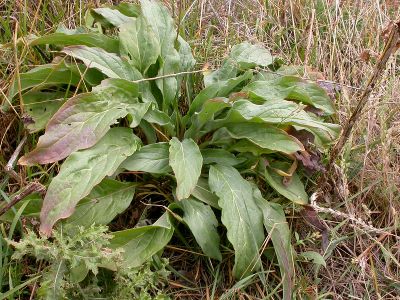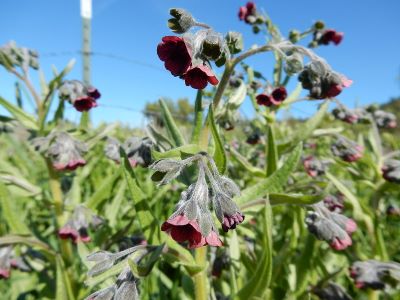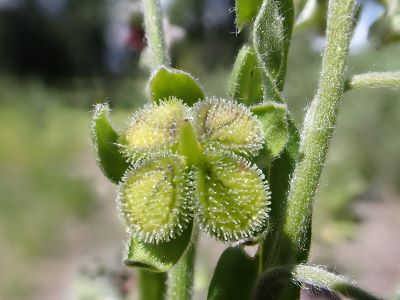Houndstongue (Cynoglossum officinale)
By Noelle Orloff, Associate Extension Specialist and Schutter Lab Diagnostician
Introduction

Photo; Matt Lavin, MSU
Houndstongue is an exotic forb in the Boraginaceae family that is on Montana’s noxious weed list. It inhabits disturbed areas of pastures, fields, grasslands, riparian thickets, and roadsides. Many people’s introduction to houndstongue is through encountering its distinctive burs on livestock, pets, or clothing.
Identification
Early in houndstongue’s life cycle, soft, greyish green leaves with smooth edges form rosettes up to 50 cm wide.After the plant starts bolting, stem leaves are alternately arranged. Houndstongue grows up to one meter tall, and soft, short hairs cover the plant. Flowers are tubular, and composed of five fused, reddish-purple petals. Seeds are flattened, teardrop-shaped nutlets with prickles. Nutlets form in clusters of four.

Photo; Matt Lavin, MSU
Biology, Ecology, and Impacts
Houndstongue is a biennial or short-lived perennial species. It usually forms a rosette its first year, flowers and goes to seed the second or third year, then dies. This species has a taproot, and only reproduces by seed. Seeds are viable for two to three years in the seedbank. Spread occurs when burs adhere to livestock, pets, or other passersby and move to a new location. One important impact of houndstongue is toxicity to livestock. The pyrrolizidine alkaloids that can be present in this species are known to cause liver disease in cattle and horses. It is relatively unpalatable when green but is consumed more readily when growing in areas lacking in desirable forage, or when cut and dried in hay.

Photo; Matt Lavin, MSU
Management
Houndstongue reproduces only by seed, so preventing seed dispersal and seed production is key to its management. With its relatively short longevity in the seedbank, preventing seed production can be an effective means of managing populations if accomplished for a few years. Mechanical control like hand-pulling and digging can be used to control houndstongue. For these methods to be effective, the root crown must be removed. For herbicide options, 2,4-D amine is effective in the rosette stage, and metsulfuron and chlorsulfuron are effective if applied when plants are actively growing. No matter which control method is used, maintaining or establishing a competitive plant community will help prevent and manage disturbance-adapted species like houndstongue.
Houndstongue Biocontrol Status
There are no biological control agents currently approved for houndstongue management in the United States. A petition for approval of the release of the seed feeding weevil Mogulones borraginis is working through the regulatory approval process. The root weevil Mogulones crucifer is present in Montana, but is not currently an approved biocontrol insect, meaning it cannot be intentionally moved.
See the MSU Extension publication Houndstongue: Identification, Biology, and Integrated Management for more information about houndstongue and its management.
Further Information
For more information about this month's weed post, contact Noelle Orloff. Past posts are available in the Monthly Weed Post Directory.
This weed post is also available as a printable PDF (311 KB).
